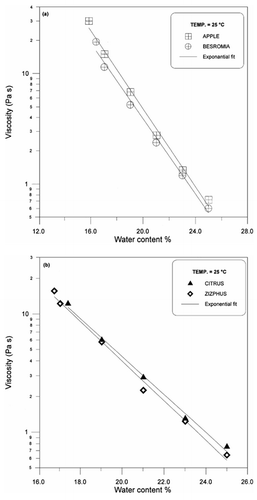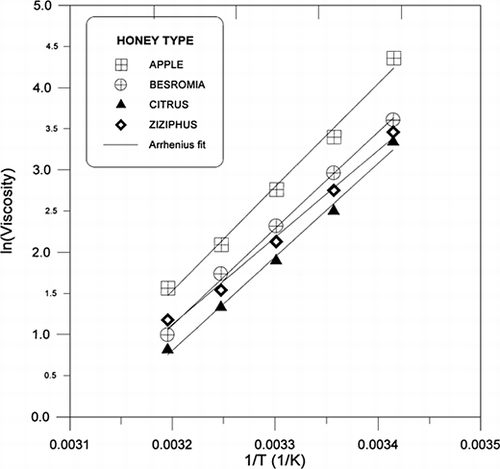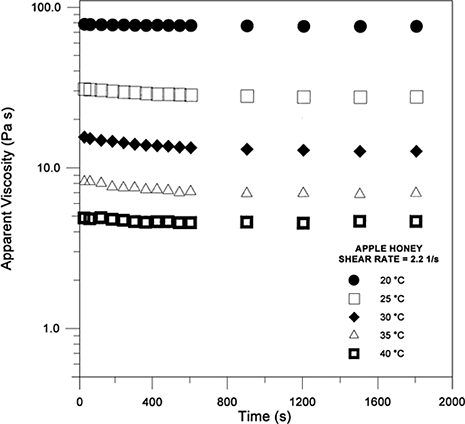Abstract
The rheological properties of Apple, Besromia, Citrus, and Ziziphus types of light colored Jordanian honey were examined. The types of honey used were identified via assessing the source of nectar using pollen analysis (Melissopalynology). The moisture content of honey samples was indirectly assessed via measuring the refractive index of the sample using a refractometer. A rotational, concentric cylinder viscometer was used to measure rheological properties of honey samples. The apparent viscosity was measured as a function of the shear rate. In addition, the apparent viscosity was measured, at constant shear rate at 2.2 s−1, as a function of shearing time. Newton's law of viscosity was found to adequately describe the flow behavior of honey samples. The apparent viscosity was found to decrease with temperature, and the temperature dependency of viscosity was found to follow the Arrhenius model. Moreover, the viscosity was also found to decrease with moisture content of honey. An exponential fit was used to describe the water content dependency of viscosity.
INTRODUCTION
Honey, as extracted from the comb, is an aqueous dispersion of materials including inorganic ions, saccharides, colloidally dispersed macromolecules of protein and polysaccharides, spores of yeast and molds, and finally the pollen grains. Sugars (mono-, di-, and polysaccharides) comprise the major constituent of honey. Next is water or moisture content. Consequently, the physical properties, including refractive index, viscosity, and density, are mainly governed by the sugar type and sugar content (or water content). Nevertheless, the sugar content of honey quantitatively and qualitatively exhibits a distribution of values rather than a unique value; hence, the physical properties of honey are expected to reflect such variability in sugar content.
Open and Schuette (1939) used the free falling ball method to correlate the viscosity of different samples of honey with moisture content (12–20% wet basis) in the temperature range between 30 and 50°C. They found that viscosity decreased with the increase in water content and temperature. Lothrop (1939) studied the effect of composition of honey on viscosity. Although adjusted to equal moisture content, the viscosity (at 40°C) of alfalfa honey (Medicago saliva) was about 0.311 Pa s, whereas sumac honey (Rhus) was about 0.411 Pa s. Lothrop attributed the variation in viscosity of honey to nonsugar materials, namely, dextrin and other colloidal materials present in honey. Junzheng and Changying (1998) examined the rheological properties of different types of Chinese natural honey. They found that the shear stress versus shear rate data was adequately described by Newtonian model, and that the viscosity decreased when both water content and temperature were increased. Bhandari et al. (1999a) examined the rheology of selected Australian honeys over a range of temperatures (4–30°C). The examined Australian honey varieties exhibited Newtonian behavior and the effect of temperature on the viscosity of honey was described by the Arrhenius-type relationship. Bhandari et al. (1999b) made a thorough review regarding the rheology and crystallization kinetics of honey. They emphasized that the flow properties of honey are influenced by several factors such as composition, at the top moisture content, temperature, and amount and size of crystals.
This work focuses on studying the rheological properties of four types of light-colored Jordanian honey. A rotational, concentric cylinder viscometer was used to measure rheological properties of honey samples within the temperature range of 20°40°C. Moreover, the effect of water content on the viscosity of honey was examined by diluting honey samples up to 25% water content.
EXPERIMENTAL SETUP AND METHODOLOGY
Materials and Setup
Four samples of natural capped honey were collected from honeybee colonies located in four different regions in Jordan. Samples were collected during the year 1999 from the apiaries of well-known management systems. Honeycombs were uncapped, extracted and professionally treated, and were then filled in jars. To identify the types of honey used, the source of nectar was assessed using pollen analysis (melissopalynology). The melissopalynological analysis was carried out in compliance with the methodology set by the International Commission for Plant-Bee Relationships of the International Union of the Biological Sciences, as described by Louveaux et al. (1978).
The water content of honey samples was indirectly assessed via measuring the refractive index of the sample using the refractometer (Belling & Stanley Limited, England; Model No. A88121). The water content was evaluated based on the measured value of refractive index while using the data shown by Wedmore (1955), which gives the water content of honey as a function of refractive index of the sample. The dilution of honey by water was carried out at 40° using the exact amount of deionized water needed to achieve the final required water content.
Rheological flow properties of honey samples were measured using a rotational, concentric cylinder viscometer (Searle-type; Haake VT500/MV3) with a fixed outer cylinder and a rotating measuring bob. The radius of the rotating cylinder was 15.2 mm, the length of the cylinder was 60 mm, and the gap width was 5.8 mm. After a steady-state (about 30 s) value of shear stress is attained, measurement of viscosity was carried out and recorded. The shear rate varied between 2.2 and 219.8 s−1. Pumping water to the jacketed vessel of the viscometer controls temperature of the samples during measurement.
A honey sample was prepared. The apparent viscosity (η) was measured as a function of the shear rate (˙γ). Moreover, the apparent viscosity was measured as a function of time, while keeping the shear rate constant (2.2 s−1). The shear stress (τ) was calculated using the Newton's law of viscosity:
RESULTS AND DISCUSSION
Table shows each of the four types of honey used, designated by the common name, its scientific name, and its water content. Figures a through 1d show the shear stress (τ) versus the shear rate (˙γ) at different temperatures, for apple, besromia, citrus, and ziziphus honey, respectively. For all examined data, except for that of Apple honey at 20°C; Newton's law of viscosity was found to best describe the flow curves of honey. It should be pointed out that the viscosity of apple honey could not be measured at higher shear rates, simply, because of the limitation imposed by the viscometer as far as the accuracy of measurement is concerned. Table shows the regressed values of viscosity for the examined types of white Jordanian honey. The value of coefficient of determination R 2 was 0.999 on the average. Obviously, the viscosity drops with increasing temperature; a typical behavior of a Newtonian liquid or liquid-type substance. To better quantify the effect of temperature on viscosity, the Arrhenius model was used:
Table 1. Types of Honey Used, Their Scientific Names, and Water Content
Table 2. Newtonian Viscosity for Four Different Types of Light Colored Jordanian Honey, Evaluated at Different Temperatures (Water Content Given in Table )
Table 3. Regressed Parameters of the Arrhenius Model Describing Temperature-Dependence of the Viscosity for the Examined Types of Honey at 25°C
The viscosity of examined types of honey was also plotted versus the moisture content of honey. Figure a shows viscosity as a function of water content, evaluated at 25°C, for apple and besromia honey types. Figure b shows viscosity as a function of water content, evaluated at 25°C, for citrus and ziziphus honey types. As shown in figure a and b, the viscosity of honey decreases with increasing moisture content. An exponential fit was used to describe the moisture-content-dependency of viscosity. Table shows the results of such a curve-fitting. The following equation was used to describe the relationship between viscosity and moisture content for the examined types of light-colored Jordanian honey:
Figure 3. The viscosity as a function of water content at 25°C for a) apple and besromia honey and b) citrus and ziziphus honey.

Table 4. Regressed Parameters of the Empirical Equation Describing Moisture-Dependence of the Viscosity for the Examined Types of Honey
Time-dependent flow properties of honey dispersions were assessed via examining viscosity versus time data. The associated behavior is denoted as thixotropic (a decrease in viscosity with time), rheopectic (an increase in viscosity with time), or time-independent. In general, all Newtonian fluids and most non-Newtonian fluids exhibit time-independent behavior. Figures shows, for example, the apparent viscosity versus the shearing time t for apple honey. The shear rate (˙γ) was held at 2.2 s−1. Regardless of the type of examined honey and the temperature at which the viscosity was measured, there is no apparent thixotropic or rheopectic behavior. It should be mentioned, however, that Weltman model (i.e., η = A + B lnt) was used here to fit the time-dependent behavior of viscosity of honey, and it was found that the B term was quite negligible. This is another piece of evidence that honey is a Newtonian fluid that shows time-independent behavior.
CONCLUSIONS
Newton's law of viscosity was found to adequately describe the flow behavior of honey samples. The apparent viscosity was found to decrease with temperature, and the temperature dependency of viscosity was found to follow the Arrhenius model. Moreover, the viscosity was also found to decrease with water content of honey; i.e., the water plasticizing effect on amorphous food fluids. An exponential fit was used to describe the effect of water content on the viscosity. Regarding the time-dependent rheological behavior, it was found that the examined honey samples show neither thixotropic nor rheopectic behavior (i.e., the apparent viscosity remains constant with the shearing time).
Acknowledgments
REFERENCES
- Bhandari , B. , D'Arcy , B. and Chow , S. 1991a . Rheology of Selected Australian Honeys . J. Food Eng. , 41 : 65 – 68 .
- Bhandari , B. , D'Arcy , B. and Kelly , C. 1999b . Rheology and Crystallization Kinetics of Honey: Present Status . Int. J. Food Prop. , 2 : 217 – 226 .
- Junzheng , P. and Changying , J. 1998 . General Rheological Model for Natural Honeys in China . J. Food Eng. , 36 : 165 – 168 .
- Lothrop , R. E. 1939 . The composition of Honey and its Utilization-relation of Composition and Viscosity . Am. Bee J. , 79 : 130 – 133 .
- Louveaux , J. , Maurizio , A. and Vorwohl , G. 1978 . Methods of Melissopalynology . Bee World , 59 : 139 – 157 . 1978
- Oppen , F. C. and Schuette , H. A. 1939 . Viscometric determination of moisture in honey . Ind. Eng. Chem. Anal. , : 130 – 133 . 1939
- Wedmore , E. B. 1955 . The accurate determination of the water content of honeys. Part I. Introduction and Results . Bee World , 36 : 197 – 206 .


